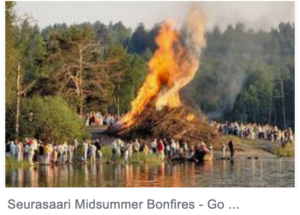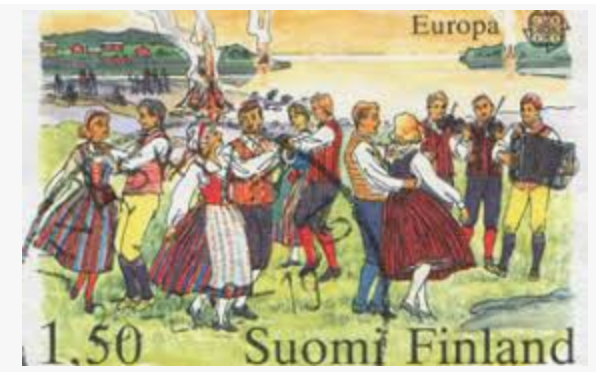Juhannus (poem)

Here is an audio of the poem, “Juhannus,” read and written by Jane Piirto. It describes the midsummer festival day in Finland, on the summer solstice.
“The moon was risen, the sun was out /
the daylight had reached the sky.” Runo 49, Kalevala
JUHANNUS
© Jane Piirto. All Rights Reserved
Helsinki, Finland–Summer Solstice
It is June 20, the quiet of Juhannus,
summer solstice, day of St. John.
Outside, no cars pass by,
apartment parking lots empty.
No one signed up
for the washing machines.
Then the stores fill up,
and this midsummer day carries
a subdued Finnish feeling
of holiday release.
Women with plastic bags
on their hands
gather new potatoes—
varhaisperhuna ulko—
to cook with dill, parsley, butter.
They crowd the fish counter, push
for their smoked salmon,
salmon, Baltic herring,
the traditional meal, with beer.
The men line up at the Alko store.
Vodka, too.
Stores close at 2.
In the streets of Helsinki
crowds thin.
The lines of cars heading out
of town to their family cottages
with saunas by the thousands
of lakes, jam,
in a chorus of brake lights.

In town, the sun shines
on upturned faces
sipping coffee at Café Strindberg
on the Esplanade.
At 7 p.m. Bus 24 picks up
passengers at all stops.
Crowds head to Seurasaari,
cross the Victorian
gingerbread bridge.
A kokko —bonfire —burns on a raft
near shore.
The smell reminds of sauna.

Mothers in city shoes,
fathers with suits on,
people in national costumes,
blond children,
babies in antenna hats
wheeled in sturdy prams,
walk wide paths through woods,
pause to watch the craftsman
turn birch on a lathe
for bowls, cups, and goblets;
watch the woman
weave birch baskets.
Birch branches festoon
the boats and paths,
wave like flags
on the fourth of July.
Flags decorate trams and buses.
Young girls with grecian
wreaths on their heads
play tug of war, boys against girls—
stilts, burlap bag races,
oak tree swinging.
Food kiosks like at county fairs
sell makaraa—sausage—
fried potatoes, pancakes, popcorn.
Stalls sell the summer beer— sahti.
People with cellular phones
stand intent, off in the woods—
in the country of Nokia
everyone is wired—
staring at the ground.
In the inner grove
a large plank dance floor
in a natural amphitheater holds
guitar, accordion, string bass players
in peasant costumes with sashes.
We mill about until
a loudspeaker announces
the bridal couple.
Crowds move to the beach.
Thousands of people
tramp through blueberry woods.
Layered twenty deep
they face the water.
Fire is the symbol
of this longest night near
water, woods, shore, nature,
the ritual marriage
of darkness and light,
beliefs concerning fertility,
cleansing, the banishing of evil spirits,
with two kokko on the beach,
five in oil pots stuck in the water,
fire to keep the ghosts at bay.

On the far shore
a man walks out with a torch,
lights a kokko on a rock peninsula.
People in pleasure boats and kayaks
watch from the harbor.
A singer sings a folk song.
The 9:40 sun shines brightly.
Loud announcements in Finnish,
Swedish, French, English,
international babel.
The man walks out again,
lights a cross of cedar branches.
With bright briefness
it flares and dies.
We stand on a slanted gray rock
beneath pine trees on a bluff.
People sit on rocks
and spread blankets.
Many couples nuzzle, kiss,
sing along to the folk songs
on the loudspeakers.
The man walks out,
lights ten small fires
around the peninsula.
He entwines arms
between two women.
He holds the torch
as they walk back.
A longboat with 18 oars appears,
people in native costume
with a helmsman,
while everyone sings.
The bride and groom
step off the bow,
she in a white gown,
he in a tuxedo.
They have an annual drawing
to choose who can get married
here, at Juhannus.
The song gets louder,
as all the people join.
The groom goes up
to the largest pyre,
cedar and upended longboats
in the shape of an evergreen.
He lights it on the sea side.
The crowd applauds.
Fire raises to the skies.
The giant bonfire burns.
The boat rows out to sea.
Quiet, the people watch the kokko
burn down, then
head back to the dancing arena.
The “Wedding Waltz” plays.
People sing as they walk.
Parents tell their children
what it means.
As the band tunes,
small blond toddlers
dance on the vast stage.
A man in a black hat
with a red striped vest
begins the adult dancing.
We meet a woman
in our national costume —
“Pohjanma” —
the land of the west north—
Ostrobothnia —Vasa,
wide and flat
home of Louhi,
the wise woman of the Kalevala.

We snap her bright blonde smile,
striped blue, yellow, and black skirt,
white apron and blouse, a headband.
Hundreds of people
wend to the stage—
polka, shottische, waltz, tango—
Finns love their dancing.
They whirl and stamp.
Crowded buses take us back.
We have a drink
in the hotel bar,
watching the
solitary drunks stagger
past the windows,
men who didn’t get
to the marriage.
The next morning,
quiet as the day before,
the nation
has a hangover.
Publication history:
Piirto, J. (2001). Juhannus. Finnish American Reporter.
- Journeys to Sacred Places. Ashland, OH: Sisu Press.
- (2008). Woodstock, NY: Mayapple Press.
